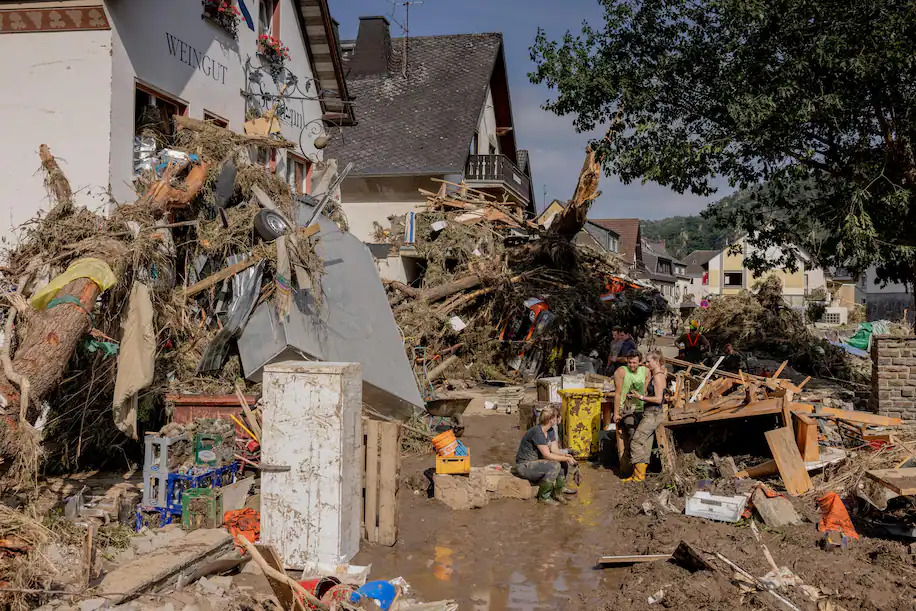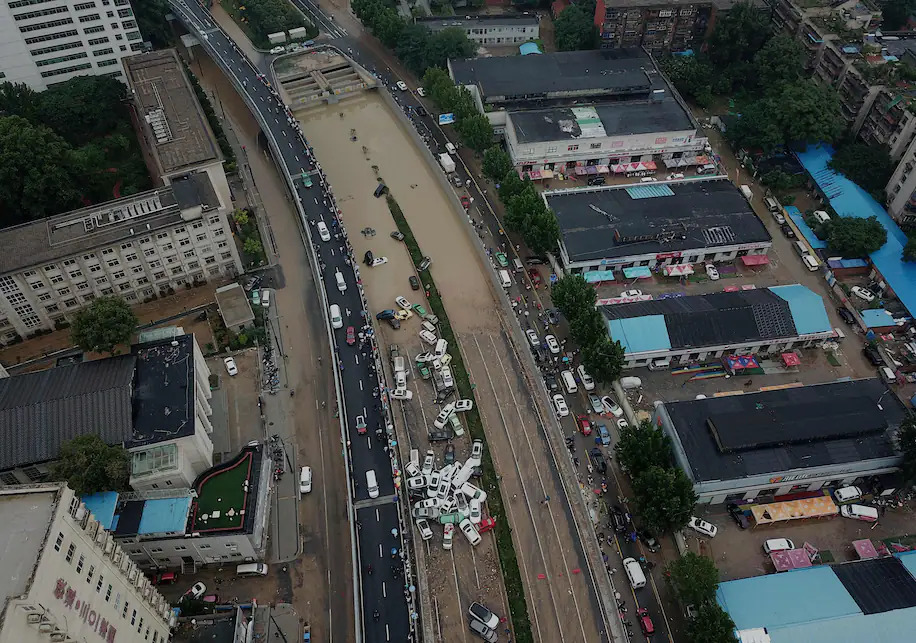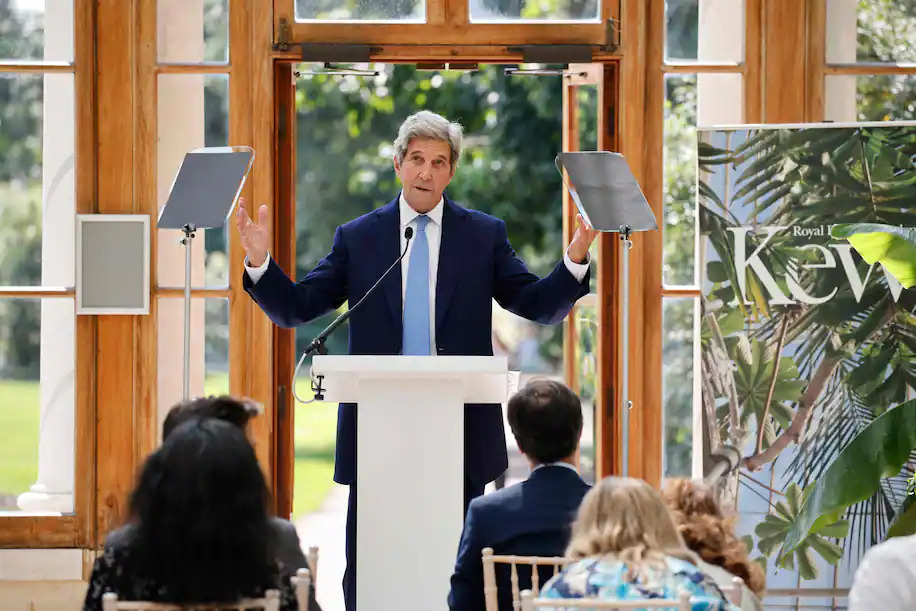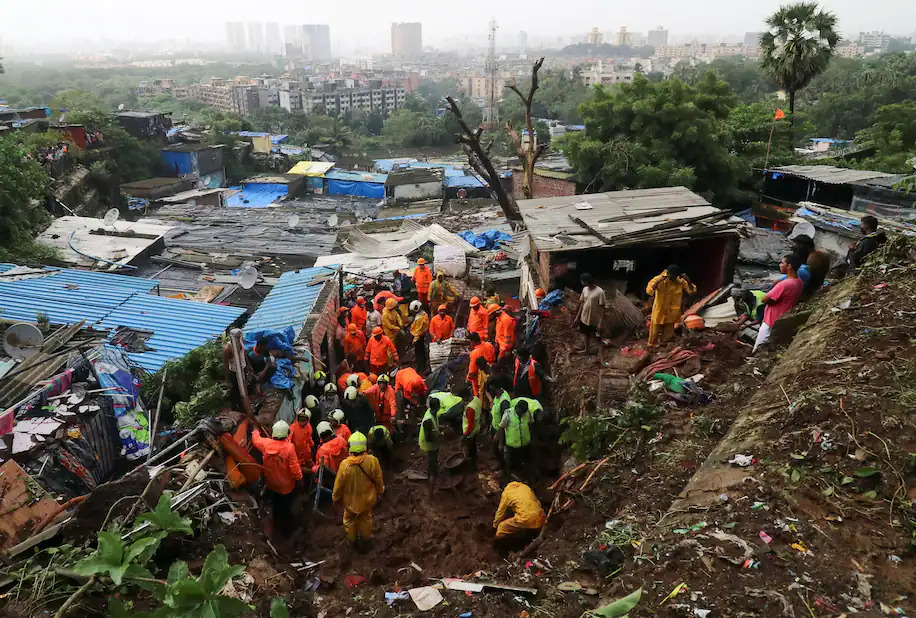The panicked commuters of Zhengzhou, China, could only stand on seats and cling to poles in a desperate attempt to keep their heads above the muddy torrent this past week, as floodwaters from record-breaking rains inundated the subway system.
On the other side of the planet, in Gresham, Ore., a 61-year-old maker of handcrafted ukuleles slowly died in June as searing temperatures made an oven out of his lifelong home — one of at least 800 victims of what one scientist called “the most anomalous heat event ever observed on Earth.”
Massive floods deluged Central Europe, Nigeria, Uganda and India in recent days, killing hundreds. June’s scorching temperatures, followed by a fast-moving wildfire, erased a Canadian town. More than a million people are close to starvation amid Madagascar’s worst drought in decades. In Siberia, tens of thousands of square miles of forest are ablaze, potentially unleashing carbon stored in the frozen ground below.
In Italy on Friday, a top U.N. climate official once again pleaded for the world to heed the alarm bells, reminding leaders that these catastrophes are simply the latest in a ghastly string of warnings that the planet is hurtling down a treacherous path.
“What more can numbers show us that we cannot already see? What more can statistics say about the flooding, the wildfires, the droughts and hurricanes and other deadly events?” United Nations Climate Change Executive Secretary Patricia Espinosa told a gathering of energy and environment ministers from G-20 nations. “Numbers and statistics are invaluable, but what the world requires now, more than anything else, is climate action.”
This disastrous summer is yet another portent of what humanity faces in coming decades if the world does not take dramatic steps to protect ecosystems and curb use of fossil fuels, scientists say.
So far, many countries have failed to meet even the modest targets they have set for reducing greenhouse gas emissions. Scientists have repeatedly warned that the planet remains on track to exceed a critical threshold for warming within a decade, a change that will accelerate the loss of sea ice, extinction of species and a dramatic escalation of weather extremes.
Yet experts and activists believe this moment also offers a rare opportunity to change course — possibly the last such opportunity before many effects of climate change become irreversible.
Governments are poised to invest billions in economic recovery as they emerge from the coronavirus pandemic, and how that money gets spent could determine whether the world clings to its reliance on fossil fuels, or shifts in a greener direction. Nations are gearing up for a critical United Nations summit this November, aimed at putting the planet on a less perilous trajectory. Scores of leaders have pledged more ambitious climate goals in the years ahead, though the rhetoric has not yet led to concrete change.
As forests burn and cities drown, as crops wither and people die, the question looms louder than ever this summer: What will it take for leaders to finally act?

Speaking before a group of powerful senators, a NASA scientist outlined the grim reality facing the planet: Human carbon emissions had raised global average temperatures to the highest levels in recorded history. Heat waves, drought and other extreme weather were disrupting people’s everyday lives.
“The greenhouse effect has been detected,” James Hansen said, “and it is changing our climate now.”
That was June 1988. Four years later, countries around the globe created the United Nations Framework Convention on Climate Change, or UNFCCC, in which they agreed to “stabilize greenhouse gas concentrations in the atmosphere at a level that would prevent dangerous anthropogenic interference with the climate system.”
Yet in the decades since, people have emitted more carbon dioxide than they did in the entire century prior. And many of the catastrophes Hansen warned about have come to pass.
“All of this is happening exactly as we have known it would happen,” said Fredi Otto, a climate scientist at the University of Oxford and co-lead of the World Weather Attribution initiative.
Otto was one of the leaders of a rapid analysis of the Northwest’s June heat wave, which found that the unprecedented temperatures were “virtually impossible” without human influence. Even in today’s world, where global average temperatures are about 1.2 degrees Celsius (2.1 Fahrenheit) above the preindustrial average, a heat wave of that intensity should only happen about once every 1,000 years.
But if the world exceeds 2 degrees Celsius (3.6 Fahrenheit) of warming, the scientists found, places such as Portland and Seattle could see these temperatures every five to 10 years.
“What we now think of as absolutely extreme heat waves will be normal summers,” Otto said.
Otto’s group is now examining recent floods in Germany and Belgium, which claimed more than 200 lives. By mid-August, they hope to quantify the extent to which climate change made the event more extreme.
Even without that data, said Hannah Cloke, a climate scientist and natural hazards researcher at the University of Reading, there is little doubt that human-caused warming played some role in the disaster. Because warm air can hold more water, climate change has increased the amount of rain that falls during storms. It’s also thought that human influence has weakened the high latitude air currents that steer weather systems, leading to slow-moving storms that deluge cities for days on end.
“It’s been an incredibly frustrating experience watching so very many people die in what was, to some extent, a predictable event,” Cloke said.
Again and again, communities have been caught off guard by the unprecedented nature of weather disasters. Many people in Germany did not receive emergency alerts about the looming floodwaters. Others failed to grasp the danger, because the event was so unlike anything that had happened before.
“We have really left our frame of reference,” Otto said. “These things are surprises because the climate we live in today has just changed very quickly.”
It’s not that scientists didn’t predict that such events could happen, she added. Forecasts from decades-old climate models closely match the changes Earth has experienced, and these models are getting better all the time.
But climate models are designed to predict changes in averages. What is clear now is that even a relatively modest shift in global average temperature allows for a whole new range of weather extremes.
Now imagine a world with almost twice as much warming — a threshold the international community vowed to avoid when it forged the 2015 Paris accord, but one that it is still on pace to exceed.
“I very much hope people take these recent events seriously for the signals that they are,” Cloke said. “We can see already what it might mean if we don’t do something now.”

As another summer brings another round of fires, floods, heat waves, drought and death, it has also raised the prospect that profound political changes could be unfolding, however slowly.
In recent days, the European Union introduced one of the world’s most detailed blueprints to confront climate change, declaring that it would cut its net greenhouse gas emissions by at least 55 percent below 1990 levels within a decade and become “the world’s first climate-neutral continent by 2050.” But the planned changes must first survive scrutiny by the bloc’s 27 member states and the European Parliament.
Senate Democrats, meanwhile, earlier this month rolled out a far-reaching set of climate proposals as part of a $3.5 trillion budget deal, including measures that would allow the United States to impose a tax on nations lagging in reducing their own pollution, as well as a fee on emissions of methane, a powerful greenhouse gas.
The proposals marked the most aggressive effort by Congress to deal with climate change and represent an attempt “to be bold enough to meet the moment,” Sen. Brian Schatz (D-Hawaii) said at the time.
But they face a gauntlet of legal and political hurdles before they can become reality. The Democrats’ narrow majority in the Senate means any proposal must win the support of moderate members whose states economically depend on producing coal, gas and oil.
A more modest infrastructure deal crafted by a coalition of Senate Democrats and Republicans includes funding for public transit, electric vehicles and projects to protect communities from climate disasters, though it omitted many of Biden’s central climate initiatives, such as a commitment to make electricity carbon-free by 2035.
American Clean Power Association chief executive Heather Zichal, a former Obama climate adviser who has been part of White House meetings on the bipartisan package, acknowledged that the deal won’t curb emissions as much as is needed. But it could “create political space” for the more aggressive budget proposal, she said, and possibly pave the way for further collaboration on climate.
“The challenge for all of us,” Zichal added, “is how do we manage incremental progress against the backdrop of what the science is telling us we need to do?”
When world leaders gather at a key United Nations climate summit this fall in Glasgow, they are expected to show up with ambitious new pledges to cut greenhouse gas emissions in coming years. Some, including the United States, have already logged new targets, ramping up what they promised in 2015 under the Paris climate accord.
But many countries remain an open question. China, by far the world’s biggest greenhouse gas polluter, has said it plans to peak emissions before 2030 but faces pressure to outline more aggressive long-term policies. Others, including Russia and Brazil, have current pledges that experts say are insufficient to meaningfully alter the world’s trajectory toward a warmer future.
And despite calls for a “green recovery” from the economic downturn of the coronavirus pandemic, a recent analysis by the United Nations and the University of Oxford found that just 2.6 percent of rescue and recovery spending by the 50 leading economies was directed toward projects, such as renewable energy infrastructure, that could end the world’s reliance on fossil fuels.
Yet another mixed signal came Friday, when environment ministers from the world’s largest economies departed a G-20 summit agreeing only that nations would make stronger commitments ahead of the Glasgow summit and would “strive” to deliver more ambitious long-term climate action. Activists had hoped the group, which includes the United States, Europe, China and India, would commit to specific warming targets and agree to deadlines for phasing out coal.
A 2020 study from the United Nations Environment Program found at the time that nations needed to triple their existing efforts to curb greenhouse gas emissions to have a chance of limiting warming to “well below” 2 degrees Celsius — a central aim of the Paris climate agreement. By the end of this decade, scientists say, the world should cut its carbon emissions almost in half to keep its most ambitious climate goals within reach.
Achieving those cuts will require monumental social changes, such as phasing out gas-powered cars, eliminating fossil fuels as a source of electricity and overhauling how humans produce food and manage land.

As political action fails to match the pace of climate impacts, leaders are left to escalate their rhetoric once more.
“It is, without exaggeration, about survival,” U.S. Special Presidential Envoy for Climate John F. Kerry said in a speech in London this past week.
He appealed to nations — particularly China — to overcome political hurdles and commit to drastic change.
“Cooperation,” Kerry said, “is the only way to break free from the world’s current mutual suicide pact.”

The world’s failure to curb carbon emissions has been felt first and hardest by people like Sandeep Mandal, a 27-year-old living in Dharavi, Mumbai, one of Asia’s largest slums.
Earlier this month, floodwaters began pouring into his cramped, one-room home. Mandal climbed onto the table to escape the deluge and watched as some of his possessions — clothes, pillows, blankets — floated away.
“I spent the night on the table till the water subsided,” he recounted. “It was very traumatic.”
Mandal, who works for a nonprofit, said his home often floods during Mumbai’s rainy season. But this year is the worst he has experienced. India’s financial capital has seen almost four feet of rain this month — 40 percent more than the average for July.
Time and again, the worst impacts of warming have hit the globe’s poorest nations, which often have the least capacity to respond. Studies show that more than two thirds of deaths from weather- and water-related disasters since 1970 have been in what the U.N. terms “least developed countries.”
In Mumbai, an estimated 110 people have been killed in landslides and flooding triggered by the recent heavy rains. For Mandal, the death toll underscored the cost of climate change paid by those who have contributed little to the problem.
Cumulative emissions from the United States and Europe account for about half of all greenhouse gases humans have added to the atmosphere. The annual emissions from an average American are about ten times those of someone in India.
The disparities are even starker when emissions sources are broken down by wealth. According to a United Nations report, the richest 1 percent of the global population produces more than twice as much pollution as the poorest 50 percent. People whose annual income exceeds $109,000, the report said, must cut their carbon footprints by a factor of 30 to help slow global warming.
Yet the events of this summer should dispel the illusion that even the rich and powerful can insulate themselves from climate change indefinitely, experts say.
In recent weeks, New York City has seen its subways flood and its skies shrouded by smoke from far-flung wildfires. Parts of London received a month’s worth of rain in a single day.
“The cry used to come from small, developing countries,” said Carlos Fuller, the permanent representative of Belize to the United Nations, and former lead negotiator for a group of island nations that work as a bloc at international climate talks.
But increasingly, Fuller said, “No one is spared. So obviously, everyone has to take action now. It is all of us. We are all in the same boat … That is what this summer is telling us.”
If there is any good to be gained from recent disasters, said Mohamed Adow, director of the African climate and energy think tank Power Shift Africa, it is the prospect that the biggest historical contributors to climate change now have impetus to seek solutions.
“I had hoped that the suffering of those in Africa and other vulnerable places might have at least been enough of a warning sign for these polluting nations to act,” Adow wrote in an email. “But they have ignored our plight and are beginning to see the folly of trying to ignore something with planetary consequences.”
Adow said he hopes this summer of fires and floods will hasten change in the nations where change most needs to happen.
“We have such little time,” he said. “If they won’t heed the warning of our suffering, then maybe they will heed their own.”

Niha Masih in Mumbai and Dino Grandoni in Washington contributed to this report.